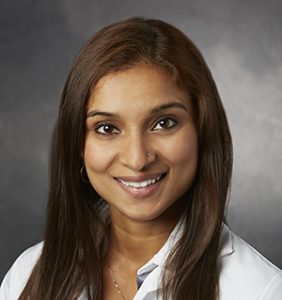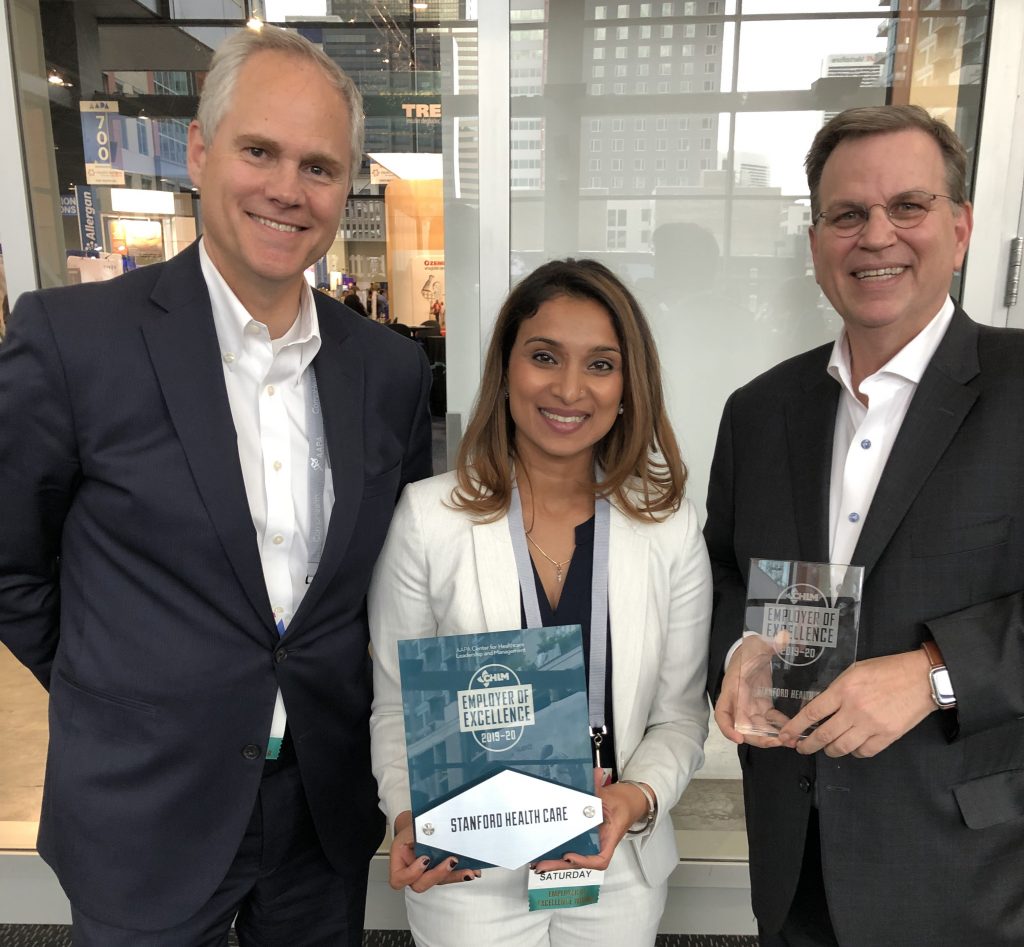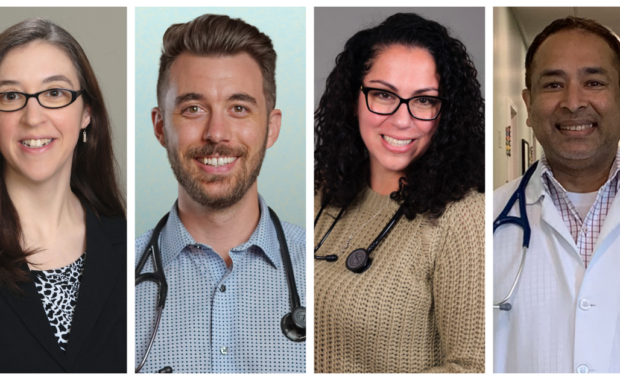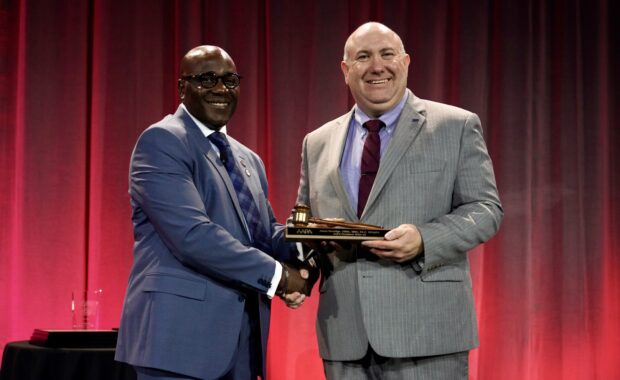Q&A with PA Leader Clair Kuriakose
Exec of Stanford’s Center for Advanced Practice Oversees 500+
July 15, 2022

Clair Kuriakose, MBA, PA-C, is a high achiever. She sets goals for herself, achieves them, and then strategically lays out her next steps. She has been doing this for years. She knew she wanted to work in the healthcare field, so she went to PA school and graduated at the age of 20. She knew she wanted to complement her healthcare knowledge with business acumen; she completed her MBA while working as a PA in pediatric surgery. She knew she wanted to work in a leadership role so she attained her Lean Six Sigma certification and hands-on management experience in a performance improvement advisory role at a health plan. And she knew that, one day, she would attain her goal of being in a job that combined all her interest areas – healthcare, business, performance improvement, and leadership.
Kuriakose found that position at Stanford Health Care, where she has been working since 2014. Following a series of promotions, she is now the executive director of Stanford Health Care’s Center for Advanced Practice, where she oversees more than 500 advanced practice providers (APPs), including PAs, nurse practitioners, certified registered nurse anesthetists, and clinical nurse specialists. She talks about her career journey, challenges she faced, her mentors, and how COVID-19 has changed healthcare.
[Career Central: everything you need for your professional life.]
Q: Why did you decide to become a PA?

A: My entire family is in healthcare! My mom was a naturopathic doctor in India where she managed her own hospital, my eldest sister is a nurse practitioner, my middle sister is a pharmacist, and my dad, although an engineer, worked at a large medical center. Surrounded by healthcare professionals, I was really motivated by the work they were doing and the satisfaction it brought them. My sister was in pharmacy school at St. John’s University when she told me about their accelerated PA program. I explored the profession and learned that as a PA I can build trusting relationships with patients and leave a lasting impact on their clinical outcomes. We’re not just managing patients, we are caring for them, and that was something I found attractive. I also liked the flexibility available to PAs in terms of specialty and work/life balance. In addition to being a PA, I’m also an entrepreneur – I started an Indian Bollywood dance school in my spare time that has since expanded to multiple cities across the country. Being a PA allowed me to pursue my passion for healthcare alongside my love for Indian arts and entrepreneurship.
Q: What made you decide to get your MBA?
A: I graduated from high school when I was 16 years old and was fortunate to be accepted into St. John’s University’s four-year accelerated PA program. I graduated with a bachelor’s degree as a PA and knew I would want to pursues a master’s degree. After graduating, I practiced as a PA in pediatric surgery for several years at Texas Children’s Hospital. It was a rewarding experience working with patients and their families. During all my experiences, I was drawn to the integration of clinical and operational workflows. I dipped my toes into this space by obtaining a Lean Six Sigma certification. It was an amazing learning experience, where I was able to make an impact on business objectives and patient care. I thought about what I wanted my career to look like: I wanted to evolve as a PA, I was interested in leadership, and I had just started my dance school. I thought that getting an MBA would really round out my education and provide me with the business acumen I was looking for. I wanted to not only get the job but be able to immediately contribute value.
Q: How did you end up in your current role?
A: I moved to California after finishing up my MBA and was searching for leadership opportunities, but many of them required you to have a nursing degree. As a PA, this was discouraging to see. I felt I could offer a lot of expertise, but I wasn’t able to find many roles for which PAs were eligible. Also, many positions wanted formal leadership experience. How do you get formal leadership experience, if leadership roles require leadership experience? I ended up obtaining formal experience in a performance improvement role at a health plan focused on improving access and quality care for underserved populations.
This experience laid the foundation for me to transition to a management position at Stanford Health Care at the Center for Advanced Practice, and it was a perfect match. I’ve been there since 2014, and it’s a job that combines all my interests – healthcare, business, and performance improvement. I became the executive director of APPs in 2017 – I love my job and I’ve never looked back! Stanford Health Care was awarded Employer of Excellence by AAPA in 2019. It’s incredible to work for an organization comprised of physician and executive leaders that value APPs and continuously strive to make a positive impact for APPs and patient care on a daily basis.
[Advance your career with leadership and management training courses.]
Q: What does a “typical” day look like for you?
A: My role is primarily administrative, but I still practice clinically and lecture at the Stanford School of Medicine PA Program when time allows. My day is full of meetings where I get to talk about the value of APPs and showcase their clinical excellence. In between meetings, I work on developing organizational strategies to help elevate the APP role. While every day is different, I always look forward to spending my evenings with my family especially my two daughters.

Q: What do you find most rewarding about your job?
A: Advocating for advanced practice providers. It’s great because I am literally hired to do just that. My job is to advocate, promote, and elevate what advanced practice looks like at Stanford Health Care. I get to go to bat for APPs on a daily basis. I’m able to design programs and initiatives that provide a sustainable infrastructure to support APPs. It’s rewarding to see how far we’ve come to advance the profession and motivating to think about how far we can go.
Q: Who have been your most meaningful mentors? How did they support your career?
A: My parents. They have always pushed me to do my best and supported me in all my decisions. My mom was an entrepreneur herself and managed a 50-bed naturopathy hospital in India during the early 1970s where it was highly unlikely to see a woman working, let alone running her own business. I am always inspired by her drive and motivation, and hope to do the same for my daughters. My dad spent majority of his career as an engineer in the healthcare industry across multiple hospitals. Growing up, this gave me a global perspective on healthcare very early on. To see his passion for helping other people, even in a non-clinical way, made me realize that healthcare is much more than one person or one department. It’s a large puzzle with many moving pieces and critical people.
Q: What challenges have you faced in your PA career?
A: For me, it’s been leadership growth. 10 years ago, it was not easy for me to get into a leadership role as a PA. PAs didn’t have a formal leadership track back then. A lot has changed in the last 10 years, and healthcare has really evolved; the sheer number of PAs nationally (along with other advanced practice roles) has grown, and an increased number of leadership roles are becoming role agnostic. I am excited to see the doors open and look forward to seeing many more PA leaders make a meaningful impact in healthcare and healthcare delivery.
Q: How has COVID-19 impacted your work? What lasting lessons have come from the pandemic?
A: COVID-19 has forced all of us in healthcare to think and act quickly, and to change what healthcare looks like. At Stanford Health Care we were able to adapt and be prepared for a potential surge and, most importantly, provide appropriate equipment to protect our staff and patients. In addition, Stanford launched multiple task forces, comprised of physicians, APPs, and operational leaders to design new care delivery models, challenging all of us to be transformational and innovative during these unprecedented times.
As traumatic and devastating as the pandemic has been, it has made healthcare take significant leaps forward. I’ve seen firsthand how APPs have taken lead and ownership to ensure their patients are receiving the care they need despite the limitations from the pandemic. APPs are critical members of the care delivery and transformation, not only at Stanford Health Care, but nationally.
Editor’s note: This article originally appeared in August 2020.
You May Also Like
AAPA’s Career Central
Leadership & Management Training Courses
Long-Time PA Leader Josanne Pagel Shares Motivations and Career Journey
Thank you for reading AAPA’s News Central
You have 2 articles left this month. Create a free account to read more stories, or become a member for more access to exclusive benefits! Already have an account? Log in.



